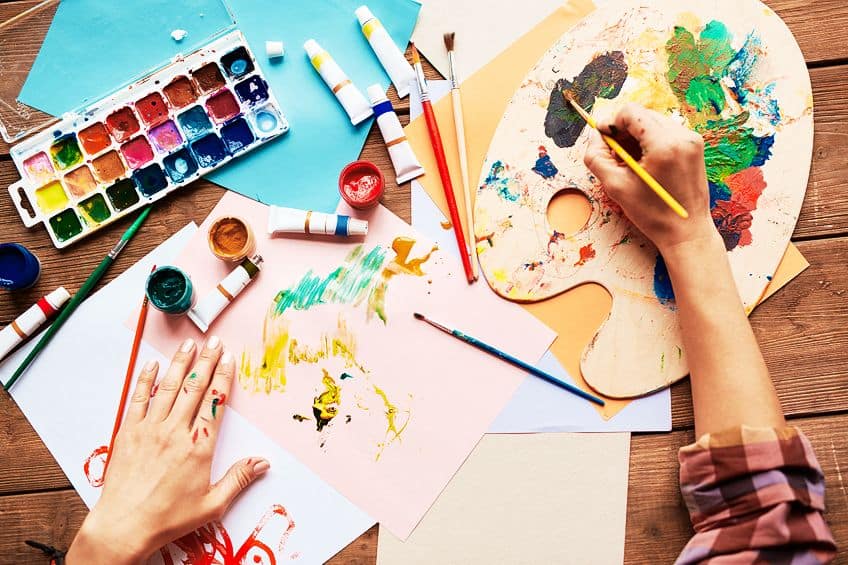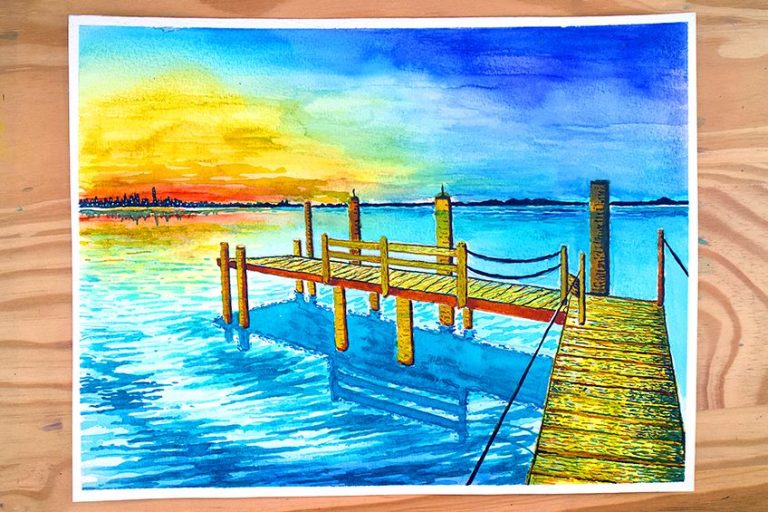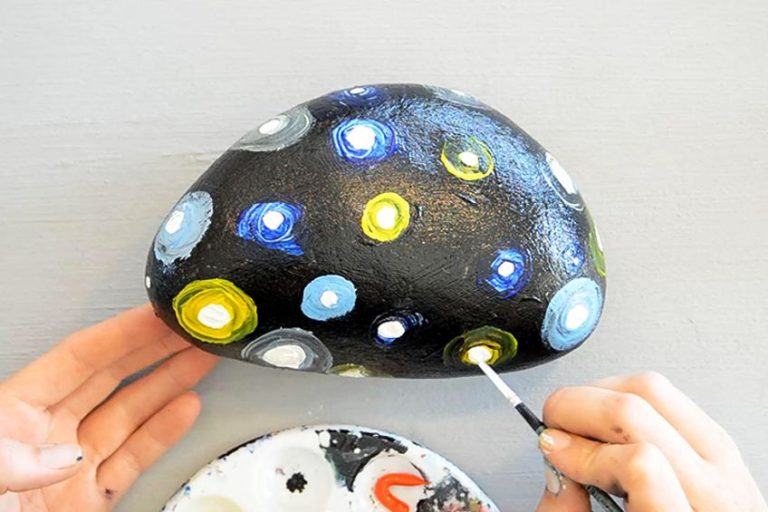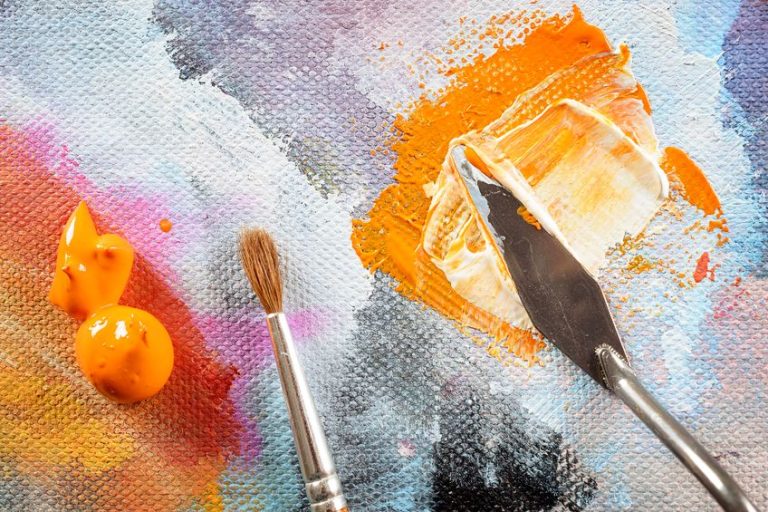What Is Gouache Paint? – Exploring the Use of Gouache Paint
You have most probably heard or read all about acrylic and oil-based paints. However, gouache, pronounced “gw-ash”, is something you do not hear or read about as often. So, what is gouache paint and why is it so admired by artists? Read on to discover more about this remarkable paint medium!
Table of Contents
What Is Gouache Paint: A Definition
Gouache is a water-soluble paint that is similar to watercolors but is made to appear more opaque than translucent. What is gouache paint made of? Gouache paints can contain natural pigments, or they can be made from synthetic pigments as well. Together with the pigments, you have a binder, which is usually gum Arabic, and water.
It can also have chalk and other ingredients to help improve the texture and flexibility of the paint. White pigment or the chalk added is what provides the opaque appearance.

Even though gouache is similar to watercolors, as it can be re-wetted or reworked, it is heavier in consistency and has a velvety type of texture and dries to a matte finish. Sometimes, it is also referred to as “opaque watercolor” paint. When compared to watercolors, it produces more vibrant colors, similar to acrylic paints. Because of this, it is often used in commercial art, posters, and illustrations.
Brief History of Gouache Paint
Gouache paint has been in use for many years and may have even been used by the Egyptians. There have been some artists over the years, who have shone a light on this paint medium. One of the earlier artists known as Albrecht Dürer (1471 – 1528) used the gouache technique in his paintings, such as in his Primula (1526).
Gouache was a popular medium during the Rococo period and many artists, such as François Boucher (1703 – 1770) painted with gouache. The Adoration of the Shepherds (1758 – 1760) is a good example of one of his gouache paintings. Later Henri Matisse (1869 – 1954) used gouache as a medium in his Blue Nudes series (1952).

In the 19th century, the industrial production of gouache began, and the cheaper binder known as dextrin was added. However, today the gum Arabic is back again, but dextrin is still used as the cheaper type of binder. The paint medium has become popular with landscape artists, commercial artists, and contemporary artists. Because of its quick-drying properties and matte look it has now become popular for use in comics, illustrations, posters, and other artworks.
Purpose of Using Gouache Paint
What is gouache paint used for? Gouache has a vibrant look because of the pigments used, and it is also lightfast. The quick-drying properties and layering capabilities also make it perfect for certain types of art. Gouache has become much more widespread and is often used by illustrators, comic artists, and other commercial designers.
It is also used to create backgrounds in cinema and is used in animation.

The medium is also great for artists who enjoy doing plein air painting. Ultimately, gouache is a versatile paint that can often imitate other mediums like acrylics, oil paints, and watercolors. In most colleges that offer art programs, you will most probably find that gouache paint is one of the
Characteristics of Gouache Paint
The purpose of gouache paint is linked to the characteristics of the medium. As mentioned, gouache can imitate other mediums and can combine certain qualities, which makes it useful and versatile. This makes gouache painting fun and exciting, as it produces amazing results. Below, you will find some reasons why artists like to use this paint medium.
Opacity
Gouache paint dries to a flat matte finish that does not reflect light. The paint also provides bold colors. When compared to watercolors, gouache has larger paint pigments, which are tightly arranged, and effectively block light.
Manufacturers also add white pigment or chalk to improve the opaque appearance.
Consistency
The consistency of gouache is quite thick, smooth, and velvety. If you add too much water to gouache paint, it can become more like watercolors. However, if you have too little water, once the paint dries, it could begin to crack.
The thickness of the paint is vital for producing the results you want.
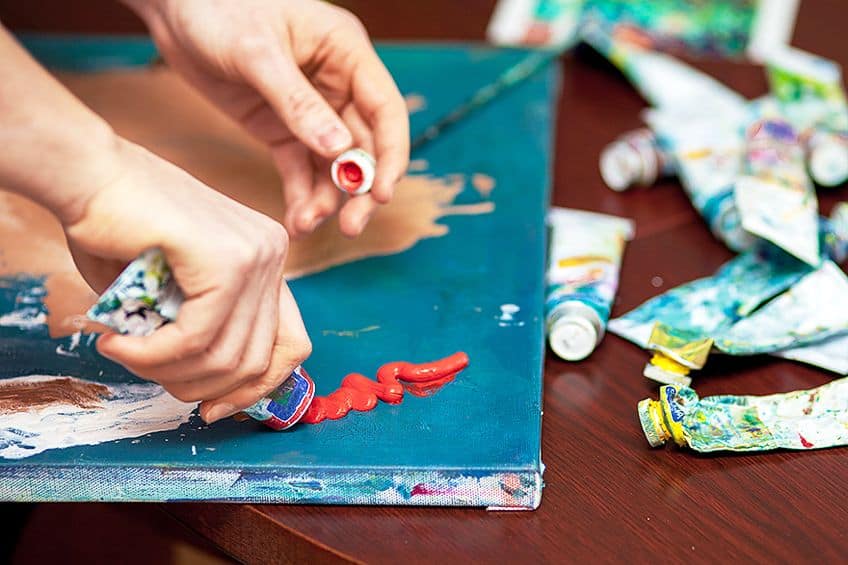
So, you should be going for a creamy consistency that goes smoothly onto the paper. The consistency of the gouache is often related to the quality of the product. So, if you are looking for quality, do not go for the cheaper versions of gouache paint.
Mixability With Water
Gouache is a water-based paint, so it easily mixes with water. The trick is to get the right amount of water when mixing. Start with some gouache paint on your palette, and always add water to the paint, gradually. Rather add smaller amounts than land up making the paint too runny.
To achieve this, you can try using a dropper when adding the water, instead of a brush.
Dry Time
The dry time of gouache is quick, as the water evaporates. This could be anywhere from 10 to 30 minutes, however, it does take longer to completely dry. Because of this, you can reactivate the paint and carry on with painting later.
Advantages of Gouache Paint
Most of the advantages are linked to its characteristics. Its fast-drying time, opacity, and mixability with water. However, gouache can also be altered. By adding more water, it can appear more like watercolors and can be used to apply thin washes. Also, because you can reactivate the paint, like oils, you can rework a painting, even after it has dried.
This means you can do a variety of painting techniques with it, from layering to scumbling. You can also use the paint directly from the paint tube.
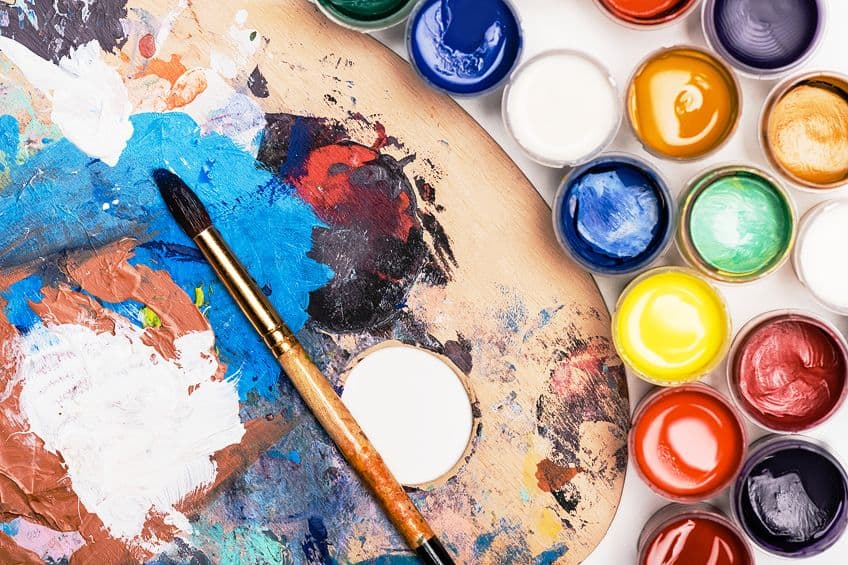
Another advantage is that you can use gouache with most other mediums, for example, you can use it with watercolors, ink, acrylic, and pencils. Let us see what other advantages there are for gouache paint.
- When using gouache, since it can be reactivated, any mistakes can easily be fixed or modified.
- As it is water-based, cleanup is simple, and you can transport it easily as well.
- Gouache is an ideal medium for beginners, as it is so versatile and easy to work with.
- The paint will not dry and clog up paintbrushes like acrylic paints.
- There is no glare or reflection off the paint, so it is easy to photograph finished art pieces.
- You can purchase gouache in pans, jars, and tubes for ease of use and storage.
- There is a higher amount of binder to pigment in gouache, so it remains on top of the surface and can be wiped off, unlike watercolors.
- You only require a small amount of gouache paint to cover an area.
- You can use nylon bristle brushes or softer brushes, depending on your needs. Many artists recommend synthetic brushes over natural brushes.
- You can mix gouache with acrylic mediums, like the glazing medium, which helps create a paint that is more water-resistant and flexible. This can help when layering paints.
Disadvantages of Gouache Paint
Unfortunately, there are also a few disadvantages to gouache paint. Since it is quite thick paint, it may require a little water to get to an ideal consistency. Below you will find a few more disadvantages, although they are not serious, and most can be worked around.
- Gouache paint is not water resistant and does not deal with dust and light very well.
- If you do apply thick layers of gouache, once it dries, this can begin to crack.
- The paint remains water-soluble, even when dry.
- Since it can be revived or re-wet, you can work on a painting for longer. However, any additional layers may lift previous lower layers, which can create muddy colors.
- Gouache paint tends to dry in slightly different shades. If you have used darker colors, they will dry slightly lighter, while lighter colors dry slightly darker.

What Is the Difference Between Acrylic and Gouache Paint?
Which paint is better, gouache or acrylic? Both have pros and cons, and it does depend on your personal preference, and what you are going to paint. Gouache is very similar to acrylic in that it offers an opaque painting effect and can help to create a superficial layer. Even though they are both opaque, acrylic paint does tend to dry opaquer and provides a bolder color. Below you will see a few more comparisons that answer the question: what is the difference between acrylic and gouache paint?
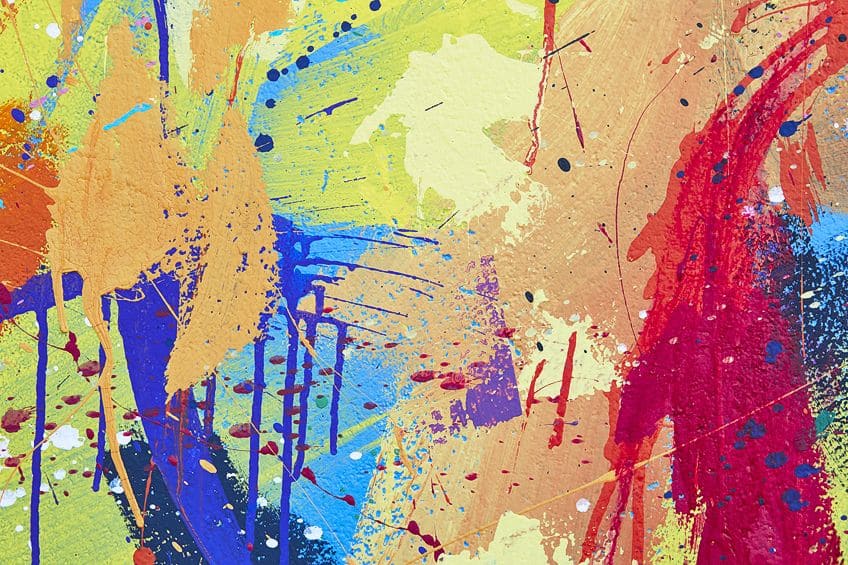
| Characteristics | Gouache Paint | Acrylic Paint |
| Binder | Gum Arabic binder | Acrylic emulsion binder |
| Water-resistant | Not water-resistant | Paint is water-resistant |
| Finish | Opaque matte or flat finish | More opaque and glossy finish |
| Durability | Less durable | More durable and flexible |
| Drying Time | Dries quickly and easily blended | Dries quickly and is more difficult to blend |
| Fixing Mistakes | You can fix mistakes easily | Once the paint is dry, you cannot fix mistakes |
| Applied Surfaces | Paper and board | Paper, board, canvas, wood, and multiple surfaces |
| Costs | More expensive than acrylics, due to the pigments used | Less expensive |
Techniques for Using Gouache Paint
There are many painting techniques that can be applied with gouache paint. You can start with a simple layering technique. However, when you work with multiple paint layers, make sure that your base layer is completely dry before applying another. As gouache can be reactivated, if you apply another layer over still-wet paint, this can cause the paints to bleed into each other, and form muddy colors. Diluting the gouache, you can also apply thin washes. Let us explore some other techniques you can use.
Wet-on-Wet Technique
Wet-on-wet, also known as alla prima or direct painting is where layers of wet paint are applied to subsequent layers of wet paint. With gouache, this works well with blending colors more seamlessly, or anywhere you do not want a nice crisp edge.
This technique might feel more like a watercolor effect, which creates soft edges and blended lines.
Dry-Brush Technique
This technique involves using a dry brush that is dipped into some paint, and then wiping most of the paint and leaving a little behind. You then use the brush to sweep across the paper, which then produces a textured look, and is used to create a soft or blurred look. The technique is used often for atmospheric effects like clouds but can be used to create numerous other effects as well. Gouache can be used to create a variety of textures.

Glazing Technique
Glazing is done by applying a more transparent layer of paint over another dry layer of opaque paint. Gouache does dry quickly, but we have learned that it can be reactivated with a bit of water. However, you can still use gouache to create a glaze. Simply, apply some gouache paint as your first layer.
Allow this to dry and apply a second layer of gouache that has been diluted in a bit of water, making it more translucent.
Scumbling Technique
Scumbling is similar to dry brushing in that it provides texture. Both these terms might be used interchangeably by some. The technique involves using a dry brush and applying the paint in a thin light layer over the surface, leaving behind gaps and a rough appearance. Scumbling can also use a lighter color over a darker one to create more of an effect.

Common Surfaces for Gouache Paint
The best surface for gouache paint is paper, however, the paint is also quite versatile and can be used on other surfaces. However, there are a few things you must do when using a different surface. Let us take a look at some of the more common surfaces for gouache paint.
Paper
Gouache and watercolor paints are quite similar, so the watercolor paper is a great option for gouache paints. However, you can also use other more heavyweight or thicker drawing paper for gouache paint.
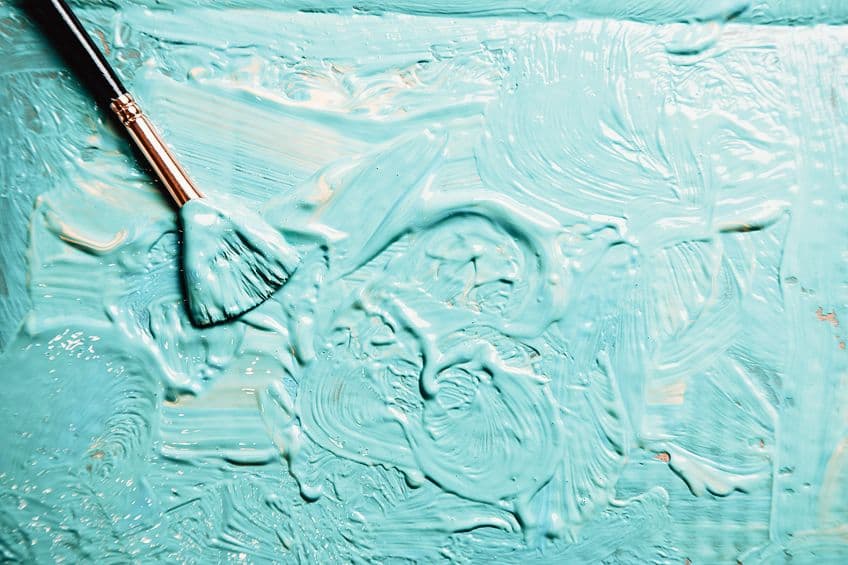
Canvas
You can apply gouache to a regular canvas; however, the surface will need to be prepared and the painting sealed. Today, you can find already prepared or primed canvases, which are great for beginners.
Gouache does not work as well as acrylics on canvas, so as a beginner, you might want to start with the various paper options.
Board
You can also apply gouache paint to various types of boards. Most board surfaces have less texture than canvas, and the paint is easily applied to the surface. Boards are also fairly stiff and thick enough to take the gouache paint. Some examples include illustration boards, simple cardboard, and museum or binder boards.

Fabric
It is not advisable to use gouache paint as is on fabric surfaces, as it is water-based and will wash or peel off when washed. You can mix gouache with other mediums like acrylic paint or use acrylic gouache paint.
Best Brands for Gouache Paint
Gouache paints are a great medium for both beginner artists as well as professionals. In both cases, you will want to get good quality paints, you do not want grainy and low-grade options messing up an art piece. When looking for gouache paints, most artists look for vibrancy, opacity, permanence, and whether the paints come as single pigments. Some of the best brand names you can look out for include the following.
- Graham Artists’ Gouache
- Holbein Artists’ Gouache
- Schmincke Horadam Artists’ Gouache
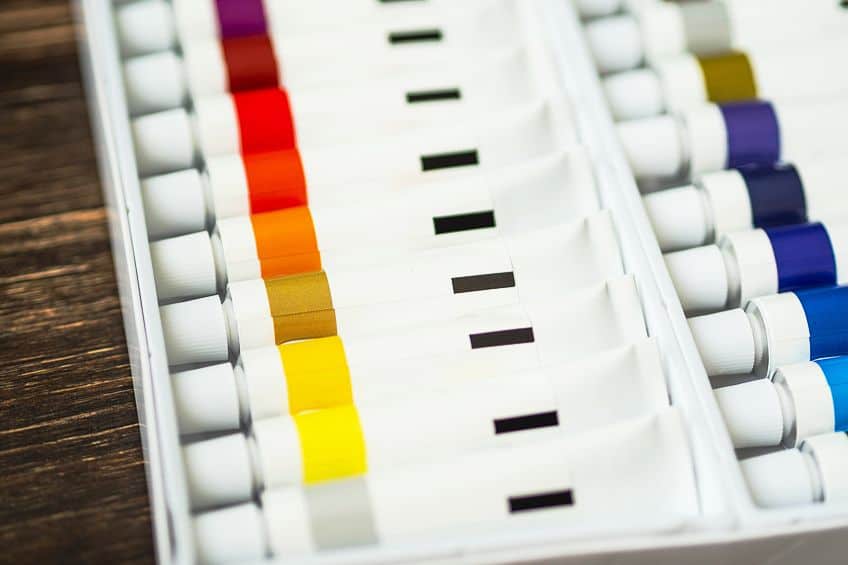
Now that you know a little bit more about gouache paint, why not try it out and discover how versatile and fun this paint medium can be? As it is such a forgiving medium, it is an ideal paint to use if you are a beginner!
Frequently Asked Questions
Exploring Different Techniques Using Gouache Paint
You have gouache and you have acrylic paints, however, today you can also get acrylic gouache. This paint medium is a combination of both and offers all the features of both paints. The paint uses a similar binder that you find in acrylic paint, but appears and acts like gouache, and is water-resistant.
What Is Gouache Paint Made Of?
Gouache paint is primarily made from three ingredients that include pigments, a binder, and water. The particle pigments in gouache are larger than in other mediums, and the binder is gum Arabic or dextrin. The amount of pigment is more than the binder, which is why gouache provides such bold colors.
What Is Gouache Paint Used For?
Many artists use gouache paint for their whole paintings, but it can also be mixed with other mediums. Because of its bold color and water mixability, it is popular with illustration artists as well as cartoon artists, and commercial artists.
In 2005, Charlene completed her Wellness Diplomas in Therapeutic Aromatherapy and Reflexology from the International School of Reflexology and Meridian Therapy. She worked for a company offering corporate wellness programs for a couple of years, before opening up her own therapy practice. It was in 2015 that a friend, who was a digital marketer, asked her to join her company as a content creator, and this is where she found her excitement for writing.
Since joining the content writing world, she has gained a lot of experience over the years writing on a diverse selection of topics, from beauty, health, wellness, travel, and more. Due to various circumstances, she had to close her therapy practice and is now a full-time freelance writer. Being a creative person, she could not pass up the opportunity to contribute to the Art in Context team, where is was in her element, writing about a variety of art and craft topics. Contributing articles for over three years now, her knowledge in this area has grown, and she has gotten to explore her creativity and improve her research and writing skills.
Charlene Lewis has been working for artincontext.org since the relaunch in 2020. She is an experienced writer and mainly focuses on the topics of color theory, painting and drawing.
Learn more about Charlene Lewis and the Art in Context Team.


